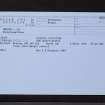Meigle
Gravestone (Early Medieval)
Site Name Meigle
Classification Gravestone (Early Medieval)
Alternative Name(s) Meigle Museum; Meigle Stones; Meigle No. 12
Canmore ID 30841
Site Number NO24SE 25.12
NGR NO 2872 4459
Datum OSGB36 - NGR
Permalink http://canmore.org.uk/site/30841
- Council Perth And Kinross
- Parish Meigle
- Former Region Tayside
- Former District Perth And Kinross
- Former County Perthshire
Meigle 12, Perthshire, recumbent gravestone
Measurements: H 1.46m, W 0.45m, D 0.27m
Stone type: sandstone
Place of discovery: NO 2877 4439
Present location: Meigle Museum.
Evidence for discovery: recorded by Skene in 1832, and by Chalmers who saw it lying in the garden of the manse in the 1840s.
Present condition: both ends are damaged and much of the carving on face D has been chiselled away. This deliberate defacing may suggest that the stone was intended for re-use as building material before or when it was transported to the manse.
Description
This monument may originally have been carved in relief on all faces except the lower face C, for there is a trace of a human leg on what survives of the lower surface of face E. On face A there is a bold pattern of pairs of plain triangles creating sunken diamond shapes, which contrasts with a wide border of fine interlace. This consists of out-turned Stafford knots, linked by diagonal strands. At the head of the slab there is the remains of a rectangular slot. The sides bear zoomorphic themes: on face B a pair of bulls about to butt heads, and a stag with a hindleg grasped in the jaws of a smaller animal, and on face D a great fish-monster with four pairs of fins.
Date: tenth or eleventh century.
References: Skene 1832, 22; Chalmers 1848, pl 19; ECMS pt 3, 333-4.
Desk-based information compiled by A Ritchie 2018
NO24SE 25.12 2872 4459.
Publication Account (1964)
No. 12 Recumbent grave-stone: on the upper surface, two narrow margins of interlaced work, a row of recessed, diamond shapes, and the socket of a small upright cross. On one side, a fish monster with long serpentine body and fins; on the other, a stag with a beast biting one of its legs, and two bulls.
S Cruden 1964.
Note (1990)
NO24SE 25.12 2872 4459.
This rectangular recumbent monument (1.46m long, 0.45m broad and 0.27m thick) has a socket at one end; both sides and the upper surface of the stone have been decorated, but the ends are damaged and incomplete. The left side was ornamented with a fish monster with many fins, now entirely obliterated. The right side contains four naturalistic animals in relief; a stag, the hind leg of which is being bitten by a dog or wolf, as well as two imposing confronted bulls. The upper surface of the slab is decorated with a striking panel of ornament and side bands of interlace flank deep recessed lozenges. The socket is broken, but has measured about 270mm by 50mm and 80mm in depth.
Information from RCAHMS (JNGR) 1990.






































